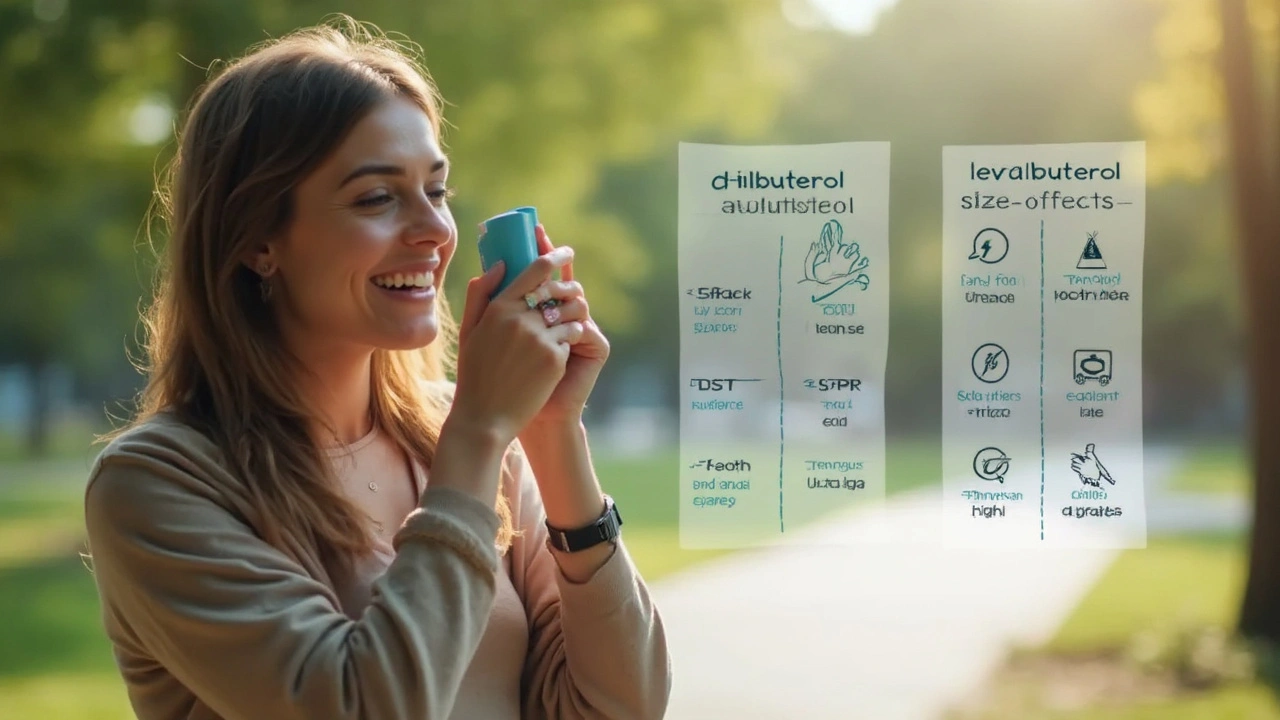Sudden shortness of breath has a way of making everything else disappear. When your airways tighten in the middle of a workout, a stressful day, or—let’s be honest—while you’re just sitting around watching TV, you want relief that hits fast and helps you breathe easy again. That’s why people always compare rescue inhalers: which one actually gets the job done quickest? Albuterol and levalbuterol are famous go-tos for anyone who’s been handed a diagnosis with the words “asthma” or “COPD.” But they’re not exactly twins. Even if your pharmacist or doctor has handed you these inhalers without much explanation, there’s real science behind how fast each works—and how they make you feel after using them.
How Fast Do Albuterol and Levalbuterol Work? The Numbers
Most folks are told they work “in minutes,” but if you want specifics, clinical data has your back. Albuterol—sometimes called by its brand name, Ventolin—has been the staple for decades. Stack up the research that’s out there, and you’ll see that after using a standard dose, most people start to feel their airways open within 5 minutes. Some studies say you can even detect bronchodilation as soon as 2–3 minutes after inhaling, but that’s in controlled conditions, and not everyone’s the same. The full peak effect, where you’re breathing as easy as you’re going to get from this dose, hits around 30 minutes.
Now, levalbuterol (brand name Xopenex) is basically the purified right-handed isomer of albuterol. That sounds like science trivia, but it actually matters: levalbuterol is the “active” form that binds more specifically to your airway receptors. If you’re hoping that means it zooms into your system faster, the truth is a bit more complicated. Studies show levalbuterol’s onset time is—surprise—almost identical to albuterol’s. A 2011 clinical trial published in the Journal of Allergy and Clinical Immunology found both albuterol and levalbuterol led to measurable improvement in FEV1 (that’s the forced expiratory volume in one second, a key measure for breathing) within 5 minutes of use. Both meds hit their peak action in about 30–60 minutes.
And just because numbers always help, here’s a table comparing actual onset and peak effect times as found in clinical trials:
| Albuterol | Levalbuterol | |
|---|---|---|
| Average Onset of Relief | 2–5 minutes | 2–5 minutes |
| Time to Peak Effect | 30–60 minutes | 30–60 minutes |
| Duration of Effect | 4–6 hours | 5–8 hours |
So while marketing might make you think one is way speedier than the other, head-to-head testing just doesn’t back that up. Both are fast, but neither is a magic bullet—how quickly you feel better still depends on how severe your attack is, your body’s metabolism, and how well you inhale the medication.

Which Has Fewer Side Effects? Here’s the Scoop
If you’ve ever used a rescue inhaler right before a big presentation or a hard workout, you might have noticed your heart thumping extra hard, hands shaking, or even feeling a bit wired. That’s not you being weird—it’s how these meds work. Albuterol, the older stand-by, isn’t picky. While it opens up your lungs, it can also hit receptors in your heart and muscles. That can mean jitters, tremors, a racing pulse, or, for some, feeling like they just slammed two espressos. For most people, these symptoms fade quickly, but they can be annoying or even scary if you’re sensitive.
Levalbuterol was designed to avoid some of that drama. Because it’s just the ‘active’ side of the albuterol molecule, it’s not supposed to hit the off-target receptors as much. And the clinical data actually supports this. In side-by-side trials, folks reported fewer racing heartbeats and tremors with levalbuterol. One study in the Annals of Allergy, Asthma & Immunology (2013) compared both drugs in a real-world urgent care setting and found that about 41% of people on albuterol had palpitations, while only 20% got them with levalbuterol. The difference was even more clear for people who are extra-sensitive or kids—parents often say their kids seem less hyper and less shaky after using levalbuterol versus albuterol.
That said, the gap isn’t massive for everyone. Some healthy adults shrug off albuterol’s effects just fine. And if you’re using rescue inhalers rarely and only as prescribed, both are pretty safe. Still, if you’ve noticed that your hands won’t stop shaking after albuterol, or if you’re stuck awake at 3 a.m. with your heart pounding, it’s worth asking your doc about making the switch.

Choosing the Right Rescue Inhaler: Lifestyle, Cost, and Real-World Tips
So, if both albuterol and levalbuterol act fast, how do you actually pick between them? First, there are some practical things that get overlooked at the pharmacy counter. Albuterol is dirt cheap (relatively speaking)—generics are everywhere, and most insurance will cover it. Levalbuterol is a newer, branded drug in many places, meaning it often costs more out of pocket. If money is tight, albuterol is usually easier on your wallet.
Let’s talk lifestyle. If you’re someone who grabs an inhaler as a backup and only uses it every now and then, either will probably work for you. But if exercise triggers your asthma, or if you have sensitive heart rhythms (like if you’ve ever had an abnormal EKG), levalbuterol’s gentler side effect profile makes it a favorite. Same thing goes if your kid absolutely hates how hyper or jittery albuterol makes them. A lot of pediatricians reach for levalbuterol for that exact reason, despite the higher price.
It’s pretty common for people to not find much difference between the two in daily life. But every so often, side effects from albuterol can push someone toward levalbuterol—and they find it’s worth the extra cash for fewer palpitations or less anxiety, especially if they’re already struggling with panic attacks.
Here are a few quick, real-world pointers to make whichever inhaler you use work its best:
- Always check that your inhaler isn’t empty or expired before you really need it. The last thing you want is to be caught without any puffs left in the can during an attack.
- Use a spacer if your doctor recommends it. These handy add-ons help make sure you actually get the full dose where you need it—in your lungs, not just stuck in your mouth or throat.
- If you keep needing your rescue inhaler more than twice a week, talk to your doctor. This means your asthma or COPD isn’t fully under control, and you might need a tweak to your daily meds.
- If you notice new or worsening side effects, don’t just tough it out. There’s no award for suffering in silence; chances are, switching types or adjusting the dose can make a big difference.
As for insurance and alternatives, many people don’t realize there’s a menu of rescue inhaler options on the market. If you’re looking for something new, or if your pharmacy runs out of your usual inhaler (yes, sometimes there are shortages), it’s smart to know what backup choices are available. There’s a super helpful post about this at Ventolin alternative—worth a look if you want to be fully prepped for the next bout of tight airways.
The bottom line? Both albuterol and levalbuterol work fast—within minutes—so you’re not short-changing yourself with either. The biggest difference comes down to how your body reacts to side effects and what fits your budget and routine. Never hurts to stash an extra inhaler in your gym bag or car, shake before using (seriously, this matters), and breathe out fully before hitting that puff so the next breath really counts. At the end of the day, the best rescue inhaler is the one you actually have on hand when you really need it.


When we contemplate the ontological substrate of bronchodilatory pharmacodynamics, the dichotomy between albuterol and levalbuterol emerges as a paradigmatic case study in molecular asymmetry and receptor affinity.
One must first acknowledge the stereochemical enantiomeric purity that defines levalbuterol, a right‑handed isomer whose chiral center dictates a heightened selectivity for β2‑adrenergic receptors, thereby modulating the kinetic cascade of cyclic AMP with a precision that is, philosophically speaking, akin to a well‑tuned symphony of intracellular signaling.
Conversely, albuterol presents as a racemic mixture, a diastereomeric amalgam that, while efficacious, inevitably engages ancillary adrenergic pathways, birthing the collateral phenomena of tachycardia and tremor.
Empirical data, captured within the crucible of double‑blind trials, delineates an onset latency of 2 to 5 minutes for both agents, a temporal convergence that challenges the layperson’s expectation of superseding efficacy.
Yet the epistemic horizon widens when we consider the pharmacokinetic half‑life, wherein levalbuterol’s metabolic extrusion, ostensibly marginally elongated, may afford a modest extension of bronchodilatory duration, a nuance often eclipsed by crude cost analyses.
From a phenomenological perspective, the patient’s lived experience of dyspnea abatement is mediated not solely by pharmacological potency but by the psychophysiological interplay of anxiety, perception, and the CNS’s anticipatory mechanisms.
Thus, the ethical imperative for clinicians resides in a judicious appraisal of both the biophysical parameters and the individual’s psychosocial context.
Distilling this discourse into actionable guidance, one might posit that for the archetype of the hyper‑responsive, cardio‑sensitive individual, levalbuterol’s attenuated sympathomimetic profile could be preferential.
In contrast, the cost‑conscious demographic, constrained by insurance formularies, may find albuterol’s generic ubiquity to be a pragmatic choice.
Nevertheless, the overarching maxim remains invariant: the temporal window of rescue inhaler efficacy, measured in minutes, is a testament to the marvel of modern medicinal chemistry.
To eschew hyperbole, both agents deliver clinically meaningful bronchodilation within a narrow epoch, rendering the “fastest” label somewhat semantically redundant.
In the final analysis, the decision matrix integrates pharmacological nuance, patient‑specific side effect tolerance, and economic feasibility.
Hence, the true determinant of therapeutic success is not a singular molecule’s velocity but the holistic alignment of treatment with the patient’s lived reality.
May this dialectic illuminate your clinical reasoning.
Sure, because inhalers solve existential crises instantly.
Ah, the classic showdown: cheap, jitter‑inducing albuterol versus its pricey, “less hyper” sibling levalbuterol-because who doesn’t love a good drama about who gets the smoother ride in the lungs?
I totally get how frustrating those tremors can be, especially when you’re just trying to get through a meeting or a workout.
Both inhalers work within minutes, so you know you’ll get relief fast, but if one makes you feel like you had three espressos, switching might make your day a lot calmer.
Look, they don’t tell you that big pharma is secretly swapping the cheap stuff with the expensive one just to keep us buying more. Trust no one.
The data show that both albuterol and levalbuterol achieve measurable bronchodilation within 5 minutes, with peak effects occurring between 30 and 60 minutes. This aligns with most clinical guidelines, which recommend a rescue inhaler for acute symptom relief.
When considering side‑effect profiles, albuterol tends to produce more cardiovascular stimulation due to its non‑selective β‑adrenergic activity, whereas levalbuterol, being the (R)‑enantiomer, has a slightly reduced propensity for tachycardia and tremor.
Good point on the side effects
Hey folks!!! If you’re juggling a busy schedule, keep an extra inhaler in your gym bag, car, or office desk!!! Using a spacer can dramatically improve drug delivery, so don’t skip it!!! And remember, consistent technique matters-shake, exhale fully, then inhale deep!!! Your lungs will thank you!!!
👍 Great tips! And don’t forget to check expiration dates-nothing worse than a dead puff when you need it! 😊
In reviewing the comparative literature, it becomes evident that both agents possess rapid onset characteristics suitable for acute bronchospasm. Nevertheless, clinicians should tailor prescribing practices to individual patient tolerability and financial considerations.
Well, where do I even begin? First of all, let’s acknowledge the obvious: the pharmaceutical industry loves to throw around the terms “fast‑acting” and “more selective” as if they’re magic words, and most patients, bless their hearts, swallow that marketing spiel without a second thought.
But dig deeper, and you’ll find that the actual clinical difference between albuterol and levalbuterol is, frankly, marginal at best; both achieve bronchodilation within the same 2‑5 minute window, and both reach peak efficacy around the half‑hour mark, give or take an hour.
Now, if you’re the type who values a side‑effect profile that doesn’t turn you into a jittery squirrel after a single puff, levalbuterol might seem appealing, yet the price tag attached to that modest improvement often feels like a slap in the face for those of us watching our healthcare costs balloon every year.
On the other hand, albuterol’s generic status makes it the go‑to for most insurance plans, and unless you’re particularly sensitive to tachycardia or tremor, you’ll likely never notice a substantial difference in daily life.
In sum, the decision should hinge less on lofty promises of “faster” or “cleaner” and more on personal tolerance, budget constraints, and the simple fact that having any functional rescue inhaler on hand is far better than being caught off‑guard without one.
Yo i think u all overcomplicate dis its just inhalers pick what works 2 u and stop actin like its rocket science